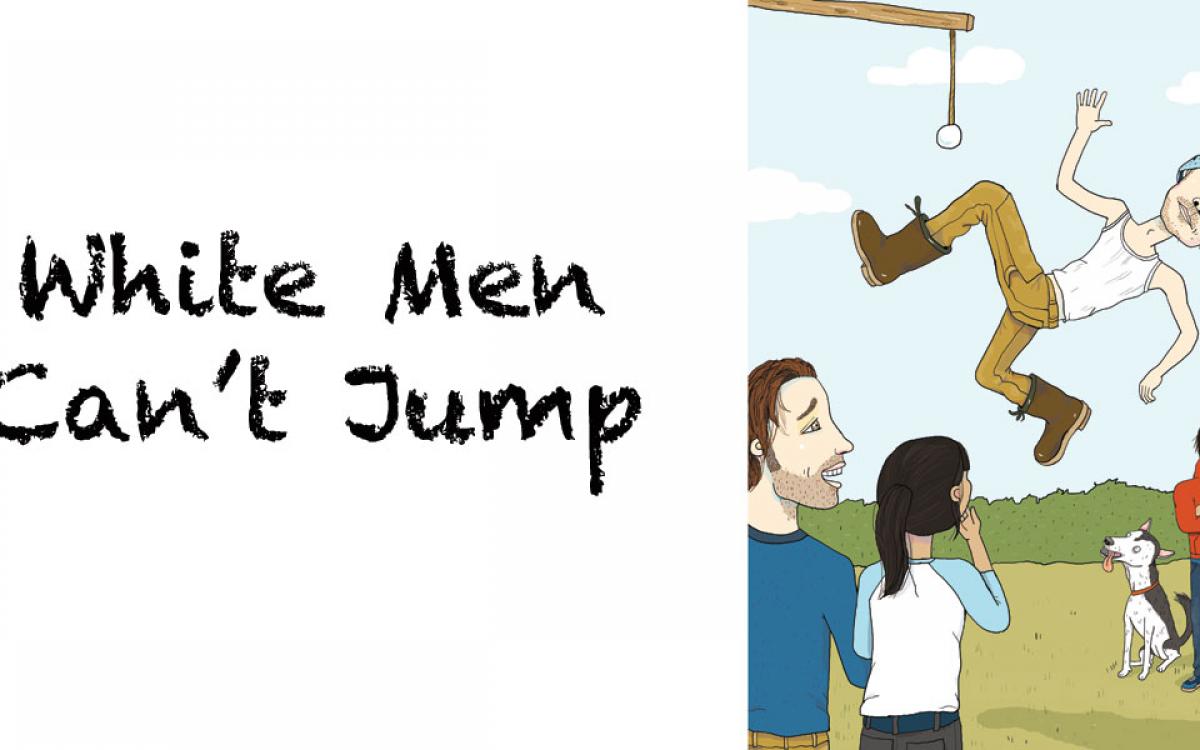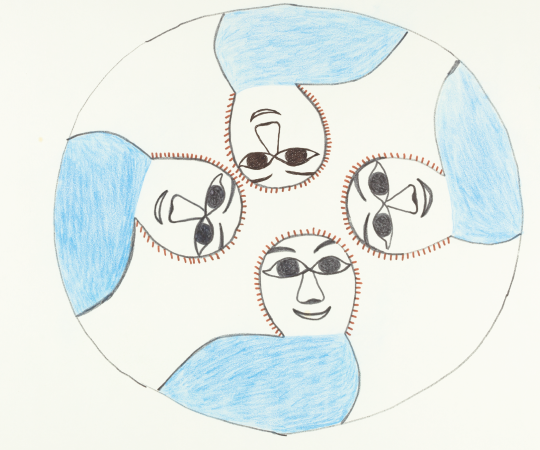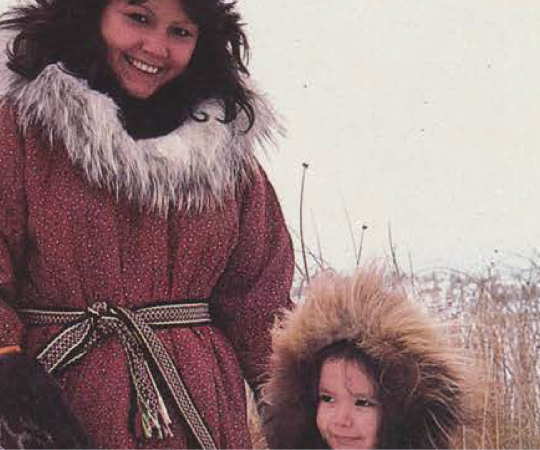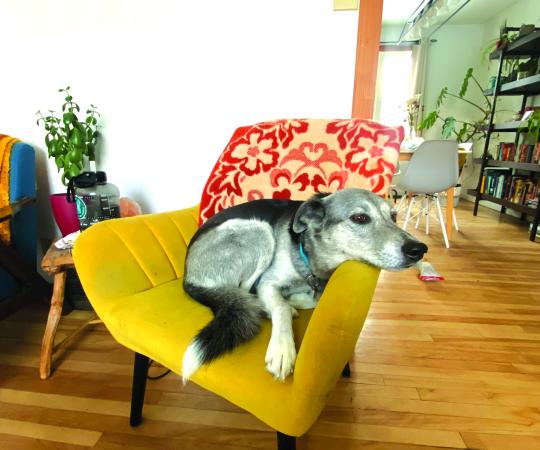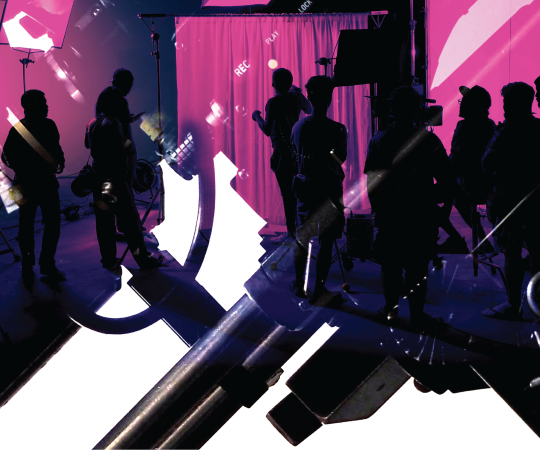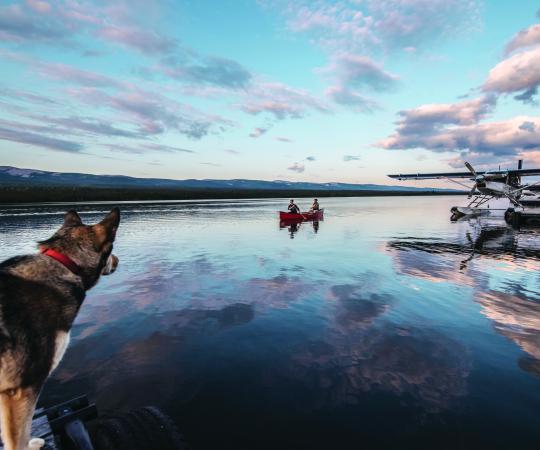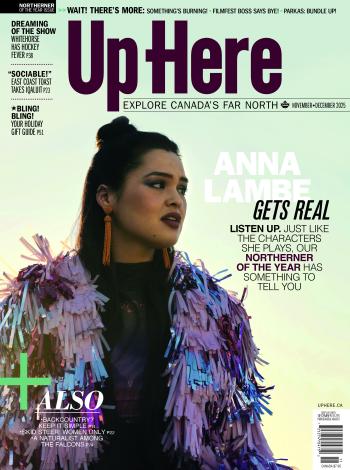Today, December 16th, my mission begins. I’m lying on my stomach in my living room, arms extended perpendicular. I look like I’m about to be crucified, and I feel like it, too. If all goes well, my friends Neville, Paul and Vince, who are standing over me, will lift me by my clenched fists and feet and I’ll be floating, rigid in the shape of a T. In the Arctic this is called “the airplane,” a traditional Inuit game, and I’ve heard it hurts like hell. On the wall near my desk at work there’s a postcard of an Inuk guy doing it. He looks stoic. I’m amazed he’s not screaming. Up here in Nunavut, that kind of guy is a hero – an Arctic Sports champ, tough as nails. I, meanwhile, am a tall, lanky white guy, transplanted to Iqaluit from my hometown of Toronto. Which is why, when my editor at Up Here called me yesterday and suggested I try out for Nunavut’s Arctic Sports team and compete in the 2012 Arctic Winter Games in Whitehorse, I should have done more research before saying yes.
“One! Two! Three!” shouts Neville. I hold my breath, clench my fists, and am lifted a few inches above the floor. Then I collapse. Hearing the thud, my girlfriend, Alana, walks into the room. “You’re going to hurt yourself,” she helpfully points out. But I hadn’t held the airplane long enough to hurt myself. I’d failed long before that.
December 19
Countdown: 39 days
Despite my belly-flop, today I printed my application from Sport Nunavut. I learned there’ll be a local tryout here in town next month – and, if I make the cut, a territory-wide tryout in the little hamlet of Gjoa Haven at the end of January. I also learned I’ll be competing in the “open men’s” category, for guys born before 1995. I turned 13 that year, which I suppose gives me a head start – though physically, I’ve squandered the past half-decade since the end of varsity rugby. I hope I haven’t gone soft, because there’s a good chance I’ll get hurt, or worse, become a laughingstock. The Arctic Winter Games are huge – the North’s Olympics, basically. They happen every two years in a different Northern city, and include sports ranging from badminton to biathlon. Always, though, the Arctic Sports are the highlight. I’ve never tried them before, only watched them on YouTube. But I know that when the finals happen, hundreds of spectators pack the stands, clapping and chanting and jostling for the best view of some of the most fantastic athletic feats they’ll ever see.
There are 10 events, and I’ve written them all down in my notebook: One foot high kick. Two foot high kick. Alaskan high kick. Kneel jump. Airplane. One hand reach. Head pull. Knuckle hop. Sledge jump. Triple jump. Each is a test of strength, courage and flexibility. Traditionally, it’s said, Inuit played these games during the long winter months, cooped up in their igloos. The purpose was to stay fit, but also to have fun – which is weird, maybe, unless you consider suffering fun.
On the form I name Alana as my emergency contact. The fax machine sings and my papers are tugged through, making my entry official.
December 25
Countdown: 33 days
It’s Christmas Day, and already the injuries are piling up. Three days ago, while doing a handstand for the one hand reach, I yanked the ligaments in my shoulder. The next day, I couldn’t lift my left arm to drive my truck. Since it’s a manual transmission, my right hand had to do all the work, splitting time between switching gears and steering.
Then, last night, Christmas Eve, I spent two hours at the Iqaluit hospital, waiting to get stitches in my finger. There’d been a party at a friend’s house, and when everyone heard about my bid for Team Nunavut, they wanted to challenge me. It started well: I went 5-1 in leg wrestling. Then I set the house record for broomstick-jumping – like jumping rope, but with a rigid aluminum rod. I think I also drank the most eggnog. That’s when I gashed my finger on the broomstick and gushed blood everywhere. When I woke up this morning, my finger was wrapped in a bandage and I decided leg-wrestling and broomstick-jumping weren’t a valuable use of my training time.
January 6
Countdown: 21 days
Today I received the news there won’t be an Iqaluit playdown. It turned out there were only three entries from Iqaluit, and two were from me – an apparent problem with the fax machine. This means I’m automatically going to Gjoa Haven. Alana burst out laughing when I told her. Then she assembled an outfit for me: a white tank-top and short yellow shorts with red stars. She wanted to imagine what I’d look like – the lone white guy, so pale I glow, standing amid dozens of strapping Inuit. “You should grow a moustache to look extra creepy,” she suggested. When I imagined the scene, I felt a bit sick. I knew that all of Gjoa Haven would show up for the trials, and during all 10 events I’d be in the spotlight. What if they heckled me? In university, an opposing rugby player once ridiculed my slender physique by calling me a “baby giraffe.” To cheer me up, Alana tickled me. I re-tweaked my shoulder and crumpled to the ground.
January 9
Countdown: 18 days
Tonight I trained for the first time in earnest. I went to Iqaluit’s squash club, overturned some chairs and jumped over them 100 times. Then I tried to kick the bottom of a basketball net. I figure I kicked about six feet high, leaving me a half-foot short of the minimum starting height for the one foot high kick. In the change room, a middle-aged Hungarian bragged to me that he’d lost 30 pounds in the past two months. I wonder if he’d take my place?
January 20
Countdown: 7 days
If it wasn’t already clear, it is now: I’ll never make Team Nunavut. For the past two weeks, I’ve been training on my own – stretching like crazy, jumping up and down, hopping on my knuckles, balancing on various limbs. Then I decided to meet my competition. I called up the other athlete from Iqaluit, Thomas Johnston, and asked him to practice with me.
It turns out Thomas has been in the Arctic Winter Games before, and is full of advice. “Jump knees first!” he told me as we did the two foot high kick. He also put me through drills he learned from his coach. (He has a coach!) He warned me that, even in the jumping events, my height won’t be an advantage. “There are a lot of really short guys,” he said, “but they float in the air.” At the end of the practice, he mentioned he once fractured his wrist in the lead-up to the games. Fearing he’d be dropped from the team, he removed his splint and competed, pain be damned. This guy is way tougher than me.

January 27
First day of competition
Today, with my lightest sneakers in my duffel bag and dread in the pit of my stomach, I made the epic journey to Gjoa Haven. It started lonely, then turned embarrassing, then became shockingly fun. After Alana hugged me goodbye in the Iqaluit airport, I flew to Rankin Inlet and waited around for the charter flight to Gjoa. I was hesitant when I boarded, but it was no big deal: Everyone assumed I was a coach or chaperone of some sort. It wasn’t until we landed in Gjoa Haven that the athletes were split off. There, in the snow-covered parking lot of the hamlet’s one-room airport terminal, I climbed onto the bus designated for competitors. The youth on board asked if I was lost. When I explained I wasn’t, they roared with laughter. One young girl gave me a high-five, someone tossed me a red T-shirt with the word ATHLETE on the back, and we rumbled off to the gym.
It was there that I knew my fears had come true. The place was packed – hundreds of Gjoa Havenmiut sitting in the bleachers and standing against the walls. We entered in a procession, led by three referees, four Canadian Rangers and a Mountie in his brilliant red serge. Then, community by community, we were introduced. When they called “Iqaluit,” I didn’t raise my hand, hesitant to draw attention to myself. A few names later, when they said “Kugluktuk,” one of the athletes who waved to the crowd was another lanky white man. I didn’t know whether to love or hate him.
That night, there was only one event: the one arm reach. When my turn came, I shuffled across the gym floor and knelt beneath the dangling sealskin target. I jammed my elbow in my gut and balanced on my left hand, my legs floating perpendicular, my right hand stretching toward the ceiling. On my first swat, I smacked the sealskin and the crowd let out a little cheer. In the next round the target was two inches higher, but I hit it again. One by one the other competitors fell away. I maxed out at 4’10” and wound up in fifth. Not bad at all – and since my nemesis from Kugluktuk had dropped out early, I’d placed first in the white-guy standings.
January 28
Second day of competition
The fun began today at 7:30 a.m. with a brisk walk to the gym. The air bit my nose, but I was optimistic. Yesterday went better than I could have imagined.
The first event was the kneel jump, which I was terrible at. Yet the mood of the athletes was heartwarmingly supportive. They constantly offered each other, and me, encouragement and advice. And when one of them would miss their third attempt and be eliminated, they’d give the remaining athletes a little handshake. The crowd was supportive too. Families had shown up long before sunrise. A mother nursed her child; a father sat silently with his toddler – a boy who, though no more than two, had the calm face of an aged hunter. Young couples cuddled on the gym floor. Out in the hallway, two guys from Arctic Bay practiced jumping over an industrial-sized garbage can. And then there was Mr. Kugluktuk, who emerged as one of the stars of the weekend. He won three gold medals today, in the triple jump, sledge jump and two foot high kick.
For me, the two foot high kick was the highlight. Above all else, the event seems like a spinal injury waiting to happen. “Don’t worry about landing,” someone advised me. “Your body will do it naturally.” Yeah, on my head, I thought. But it turned out to be one of the most fulfilling athletic experiences of my life. All of us hit the six-foot starting height. It then took me three attempts at 6’4” and 6’8”, but I stayed in. (I was astounded: In training I’d only kicked 5’6”.) At seven feet, when I missed the first time, a fellow competitor half my height came over and beckoned me to lean down. “You’re not pointing your toe early enough. And I can hear your feet slapping. You’re losing momentum on your jump.” After my second miss, he asked, “Do you want the crowd’s help?” He started a slow clap, and the crowd joined in. There I was, standing in the centre of hundreds of onlookers as the room throbbed with the rhythm of their clapping. I stepped forward, didn’t slap my feet, pointed my toes, snapped my legs into the air, and threw myself at the target. I missed. After high-fiving all my competitors and the referee, I watched as the other white guy nearly set a world record.
January 29
Final day of competition
Breakfast today was pancakes, sausage, eggs and yogurt, which were all far too heavy, but everyone had some, so the playing field was even. We battled through the first two events of the day and then it was time for the one I feared most, the airplane. As I lay on the floor in the shape of a T, the referee joked that I was ready for takeoff. Behind me, other athletes laughed about how far they’d fly. “I’m going to Ottawa,” said one. A really confident kid said, “I’m going to Iraq.” As for me, I didn’t even get airborne: the officials lifted my arms and I groaned as my chest sagged on the floor. The lady on microphone was generous, telling the crowd, “This was his first time trying the event.” And I wasn’t alone. Down the runway, several other athletes “went mechanical,” including a jovial man from Coral Harbor who patted his belly and said, “Too many luggages.”
I smiled through the entire closing ceremonies and the medal presentation, as girls and guys from around the territory climbed the podium and were named to Team Nunavut. In the open-male category, four men made the cut to go to the Arctic Winter Games in Whitehorse, including the dude from Kugluktuk. I finished somewhere in the middle of the pack. There was a group hug, and then most of us went to the community centre, where I collapsed on a pile of gym mats to wait for our 3 a.m. charter flight. I drifted in and out of sleep and only groggily remember one of my fellow athletes, Ralph, coming over and asking, “Are you homesick?” I thought about it, and realized I was. “You should play games with us,” he said. On the other side of the room, a gang of youths were doing the one arm reach. And despite being exhausted and sore in every muscle, I got up and joined the fun.

